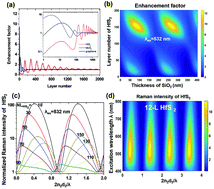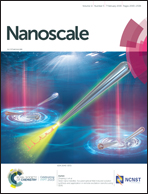Raman intensity enhancement of molecules adsorbed onto HfS2 flakes up to 200 layers†
Abstract
Newly emerging two-dimensional transition metal dichalcogenide HfS2 has received considerable attention recently due to its ultrahigh photoresponsivity, well-balanced carrier mobility and an appropriate band gap which offer potential in electronic and optoelectronic devices. In this work, HfS2 flakes up to 200 layers with varying color contrasts are fabricated and transferred on a SiO2/Si substrate. The Raman intensities of HfS2 flakes and Raman intensities of molecules adsorbed on HfS2 flakes are quantitatively studied both theoretically and experimentally by considering an optical interference effect. The effects of the main experimental factors: thickness of SiO2 and excitation wavelength on Raman intensities are also theoretically investigated. Due to the low absorption of HfS2, many strong high-order interference-induced enhancement peaks are observed which are different from high absorption materials like graphene and MoS2, in which only 2–4 interference-induced enhancement peaks exist. Due to the environmental instability of single layer HfS2 under ambient conditions, multi-layer HfS2 is a better choice than single layer HfS2 as a Raman scattering substrate which has a stronger Raman enhancement and a better environmental stability. The discovery here will expand the application of HfS2 flakes in molecular detection.



 Please wait while we load your content...
Please wait while we load your content...